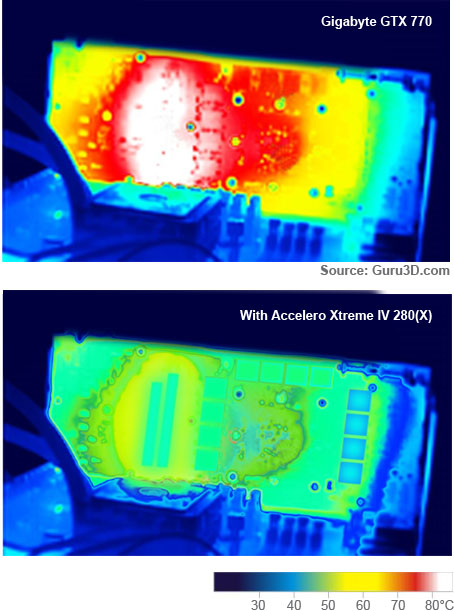Message boards : Graphics cards (GPUs) : Raijintek Morpheus VGA Cooler
| Author | Message |
|---|---|
|
I've recently changed the standard cooler of my GTX 780Ti to this Raijintek Morpheus cooler, with two Scythe Kaze jyu 100mm 2000 rpm fans (SY1025SL12M), and I'm quite amazed that the card is running at 56°C instead of 75°C, with much less noise. | |
| ID: 41941 | Rating: 0 | rate:
| |
|
I'd like to add an important notice for those, who change the original heatsink / cooler assembly on their GPU: | |
| ID: 41950 | Rating: 0 | rate:
| |
|
Impressive cooling performance! I do wonder though how such solutions improve cooling of other critical components, such as the VRMs and memory chips (esp the VRMs). Even with high quality solutions, such as EVGA, these components are treated as second-class citizens, left to be cooled by smaller heat sinks or metal plates and thermal pads. One can say, these cooling solutions are capable enough. I do not however feel very comfortable with components in my computer working 24/7 at 90-100C. Of course, others may feel absolutely comfortable! | |
| ID: 41953 | Rating: 0 | rate:
| |
|
If your cards are not HOT they aren't working hard enough :-) | |
| ID: 41954 | Rating: 0 | rate:
| |
|
Thanks for the heads-up Zoltan ! | |
| ID: 41955 | Rating: 0 | rate:
| |
I do wonder though how such solutions improve cooling of other critical components, such as the VRMs and memory chips (esp the VRMs).It usually gets better too, because the metal frame these components are attached to has no fins, it simply spreads the heat across the whole card. Moreover the thermal pads between the components and the metal frame is relatively thick, compared to the GPU's thermal interface material, resulting in poor thermal conductivity.  But there are examples for VRM thermal increase:  Even with high quality solutions, such as EVGA, these components are treated as second-class citizens, left to be cooled by smaller heat sinks or metal plates and thermal pads.Compared to the heat produced by the GPU they are really second-class :) The VRM's efficiency is between 90-95% (later, or OC models usually have better FETs), so while the GPU emits 200W heat, the VRM emits 10-20W, and the RAM chips emit about the same amount, but they are spread across a much larger area than the GPU chip. The challenge of cooling them comes from that they are very close to a 10 times stronger heat source (the GPU). One can say, these cooling solutions are capable enough. I do not however feel very comfortable with components in my computer working 24/7 at 90-100C. Of course, others may feel absolutely comfortable!A FET in the VRM, or even the RAM chips are way simpler / smaller / cheaper than the GPU, so replacing them is not a big deal, and they aren't that delicate as the GPU. Still - you are right -, the lower their temperature the longer they will work. Besides that the high temperatures wear the chips more, the whole process of heating up and cooling down (aka the thermal cycle) wears the soldering and the layers of the PCB & the chip more when the thermal peak is higher. That's one aspect of the dangers of LN2 cooling: when you apply the LN2, the chip goes from room temperature to -196°C, which is 3.5 times more change as of going from room temperature to 80°C. With Maxwell, one could think that VRMs do not get so hot as with Kepler or Fermi, since it requires less power. Less power can also be delivered with fewer VRMs working harder however, so cards end up with fewer, but also equally (or almost) hot VRMs.That's why OC cards have more "phases" in their VRMs: less heat emitted by each component in a larger area. | |
| ID: 41959 | Rating: 0 | rate:
| |
|
Thanks for your response Zoltan! You are absolutely right in your observations / conclusions. | |
| ID: 41972 | Rating: 0 | rate:
| |
Message boards : Graphics cards (GPUs) : Raijintek Morpheus VGA Cooler













